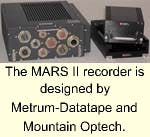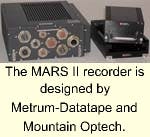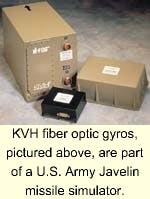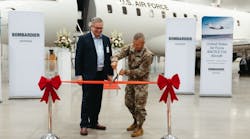Enabling technologies for military & aerospace electronics engineers
Computer peripherals
Metrum-Datatape relies on Mountain Optech for solid-state storage modules
Systems designers at Metrum-Datatape Inc. of Monrovia, Calif., needed solid-state data storage for their Multi-Application Recorder/Reproducer System product line — better known as MARS II. They found their solution in solid-state recorders from Mountain Optech Inc. of Boulder, Colo.
The MARS solid-state storage module (MARS-SSM) is designed for flight test and other rough-ride space-restricted environments, Mountain Optech officials say. The system is designed to accept MIL-STD-15553a/B data bus, NRZ-l, R-NRZ-l, bi-phase, analog, and ARINC-429 data, while keeping one channel available for voice annotation.
Mountain Optech and Metrum-Datatape officials unveiled the MARS-II SSM last summer at the Farnborough Air Show in Farnborough, England.
The MARS-II SSM features a removable memory shuttle for quick exchange of modules, scalable capability of 12, 24, or 36 gigabytes, eight digital data channels and as many as 32 analog channels, and several storage modules with SCSI interface, Metrum-Datatape officials say. — J.K.
For more information contact Mountain Optech by phone at 303-444-2851, by fax at 303-444-4431, by post at 4775 Walnut St., Suite A, Boulder, Colo. 80301, or on the World Wide Web at http://www.mt-optec.com.
Also contact Metrum-Datatape by phone at 626-358-9500, by fax at 626-358-9100, by post at 605 East Huntington Drive, Monrovia, Calif. 91016, or on the World Wide Web at http://www.metrum-datatape.com.
Board products
Primagraphics supplies U.S. Navy with COTS-based primary radar tracker
U.S. Navy electronics experts and their supporting contractors needed commercial off-the-shelf (COTS) primary radar tracking equipment for an experiment intended to help improve aircraft tracking and situational awareness.
They found their answer in the CAT Track radar tracker from Primagraphics Ltd. of Litlington, England. The CAT Tracker uses adaptive algorithms running in software, along with other engineering tools in its image processing and display system, Primagraphics officials say.
Conducting the Navy experiment are experts at the U.S. Naval Air Warfare Center Aircraft Division (NAWC-AD) at Patuxent River Naval Air Station, Md. Naval experts are working with engineers at the Zimmerman Associates Inc. American Electronics Inc. (ZAI/AMELEX subsidiary in Vienna, Va.)
Together, Navy and ZAI/AMELEX experts are fitting a T-AGOS-class surveillance ship with NAWC-AD's Identification Friend or Foe (IFF) tracker. The two inputs combine in an overall situation display to improve aircraft surveillance, as part of NAWC-AD's advanced AN/UPX-36(V) Integrated Track Management System (ITMS).
By interfacing with existing IFF and radar equipment on-board the ship, such as types SPS-40 and SPS-49, the AN/UPX-36(V) helps upgrade automated target acquisition, tracking, and display systems. The use of IFF and primary radar tracking supports identification of cooperating and non-cooperating targets.
"We are delighted with the Primagraphics COTS tracker," says Bill Shoemaker, a ZAI/AMELEX radar systems engineer. "It worked better than I ever dreamed in the summer sea trial. The integrated video provided just the type of video the COTS plot extractor was looking for and overall it will work well with any version of the SPS-49 radar."
The VME-based Primagraphics CAT Track processes radar returns from a radar antenna and automatically initiates tracks and generates track reports for output to a controlling computer. Supporting plot and track outputs are either TCP/IP or UDP/IP network standards. — J.K.
For more information contact Primagraphics by phone at 011-44-1763-852-222, by fax at 011-44-1763-853324, by post at New Cambridge House, Litlington, Nr. Royston, Herts SG8 0SS, England, or on the World Wide Web at http://www. primag.co.uk/.
Computers
BTG Selected to Build JSIMS Security Solution
Officials at the National Security Agency (NSA) in Washington awarded BTG in Fairfax, Va., a $6.5 million addition to its existing Joint Simulation System Signals Intelligence Simulation contract.
The contract is to build the Security Common Component (SCC) for the Joint Simulation System (JSIMS) Alliance. JSIMS will provide the next generation of joint military training simulations and is being supported in development by the U.S. armed services, NSA, the National Reconnaissance Office, the Defense Intelligence Agency, and a variety of specialized offices and agencies.
The purpose of the SCC program is to provide a common security framework to be used throughout the JSIMS Alliance. In supporting future training and exercise requirements, JSIMS will utilize various levels of classified data, including ultimately unclassified information that can be shared with U.S. allies. SCC will provide the initial capability to support this requirement by making it possible to protect data at two classification levels necessary for U.S. training.
Currently scheduled for development through April 2002, SCC will provide the following capabilities: the JSIMS Security Workstation will provide common security administrative services for two levels of JSIMS security enclaves; the JSIMS Up-Guard will allow for the transfer of information from the lower to the upper enclaves; and the JSIMS Out-Guard will allow the transfer of reports from intelligence simulations to operational systems used by the intended training audience.
"J-SIGSIM has been a wonderful success story," says BTG vice president Kevin Wilshere, director of the company's Modeling and Simulation practice. "This is a vital effort to provide improved representation of signals intelligence in the next generation of training simulations."
For more information on BTG contact the company by phone at 703-383-8000, by fax at 703-383-8999, by mail at BTG Inc., 3877 Fairfax Ridge Road, Fairfax, Va. 22030-7448, by email at [email protected], or on the World Wide Web at http://www.btg.com.
Sensors
KVH to provide fiber optic gyros for Army Javelin missile trainer
Engineers at ECC International Corp. in Orlando, Fla., needed fiber optic gyros for a basic-skills training system they are building for the U.S. Army to help soldiers learn how to use the Javelin shoulder-fired anti-tank missile.
They found their solution in the E-Core fiber optic gyro from KVH Industries Inc. of Middletown, R.I. KVH officials won a $1.5 million contract from ECC International on Nov. 6.
The Javelin trainer uses commercial off-the-shelf hardware in a system where the operator holds a Javelin simulator while viewing pre-programmed training scenarios through a color display embedded in the simulator's viewfinder.
The KVH fiber-optic gyros help measure the handheld simulator's movement precisely and to enable the system's computer to synchronize that movement with the virtual reality scenario showing on the simulator's display. The trainer has switches and controls that perform as they would on an actual Javelin weapon system.
The KVH fiber-optic gyros have a solid-state design with no moving parts, and no cross-axis sensitivity to vibration, acceleration, or shock. These gyros are single-axis rate sensors that measure the angular rotation about an axis perpendicular to a coil of optical fiber. — J.K.
For more information contact KVH by phone at 401-847-3327, by fax at 401-849-0045, by post at 50 Enterprise Center, Middletown, R.I. 02842, or on the World Wide Web at http://www.kvh.com/






